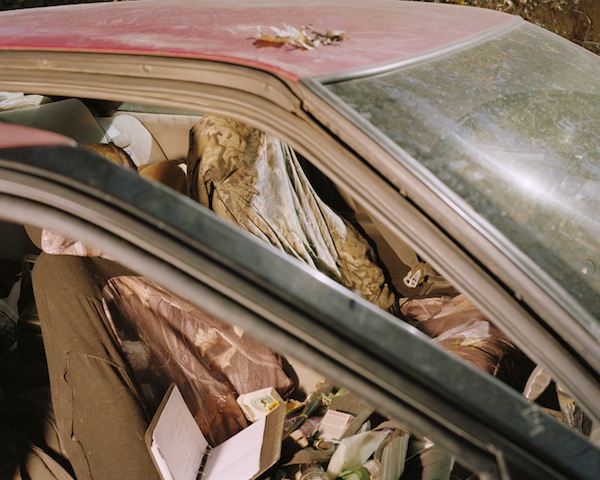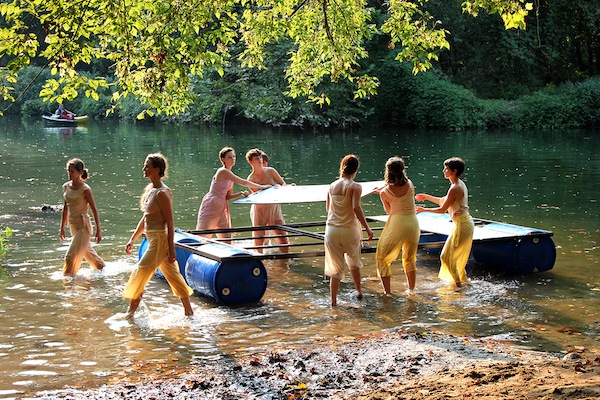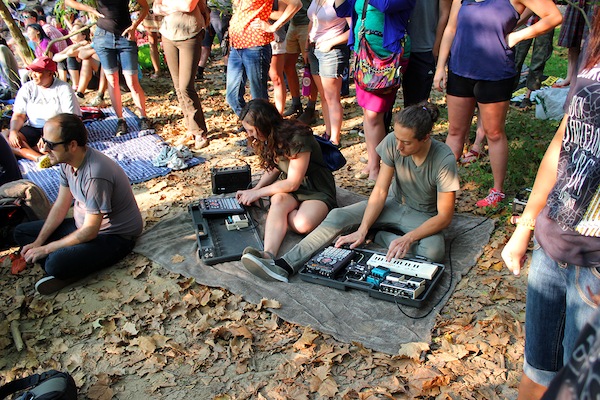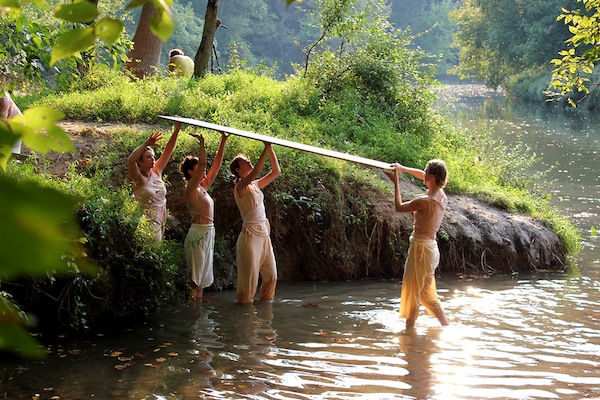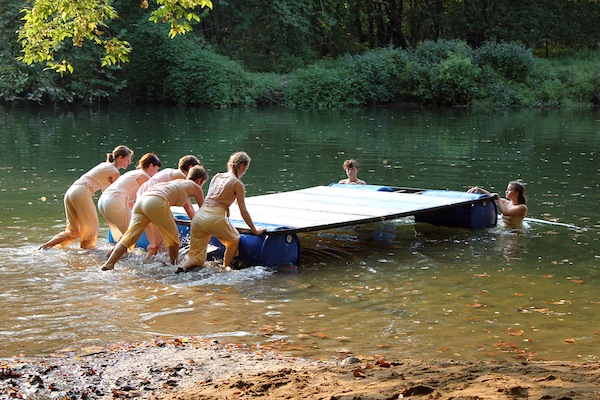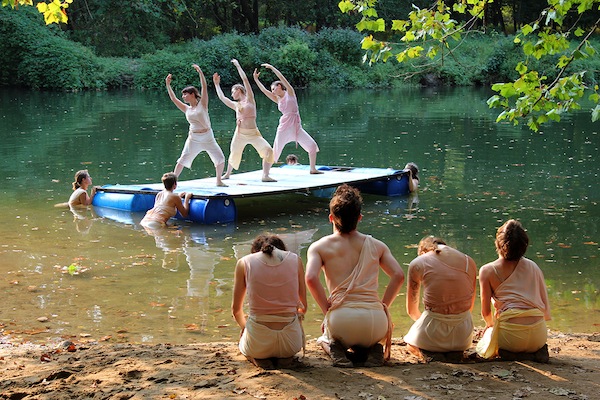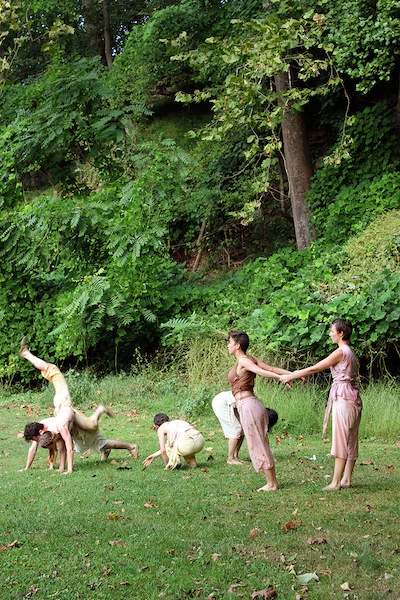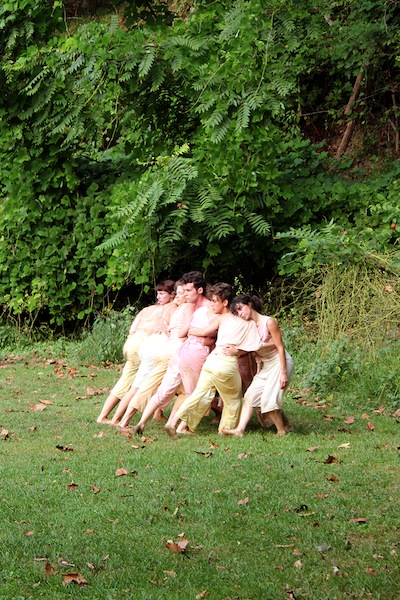For those who found their way to Patapsco Valley State Park on Sunday, September 8, Effervescent Collective offered “Pull/Drift,” an understated ode to summer’s end. Presented as collaboration between choreographer Clarissa Stowell Gregory and sculptor Joshua Wade Smith, the experimental dance performance wove and wandered adrift through woods and water, pulling the audience with it, underlining the nature of trust between audience and performer. At an arm’s reach from the city, the 45-minute experiment in movement, rhythm, and ritual created a reflective space for performers and audience alike, releasing a collective exhalation on one of the last perfect late summer afternoons.
The event couldn’t have planned for better weather. After arriving at the park, I followed a sign pointing down a footpath toward the event, closely trailed by a curious dog walker investigating the sudden confluence of cars parked along the tucked-away Daniels area entry road. I felt like I had suddenly found myself at summer camp; kayakers, horseback-riders, and hikers joined the audience at the Patapsco riverside, their perimeter designated by three costumed flag-bearers. At 5pm it was 78 degrees, with the sun lowering in the sky, glinting off the water and casting a golden glow through the leaves of trees and light fabric of loosely-draped costumes. In the distance, dancers silently evanesced into the sunlit trees, and from somewhere within the heavily nestled shore side crowd, music began.
Using a pedal board and sampler on a blanket in the sand, Rod Hamilton and Tiffany Seal complemented the dancers’ melodic movements with a repetitive, beat-driven calypso sound. The meditative, yet upbeat song guided the movements of the dancers as they reappeared from the forest, and continued to loop like a mantra throughout the duration of the performance. Music and dance have an obvious historical dependency, but the collaborative relationship between choreographers and musicians is especially unique in Baltimore, due to its eclectic electronic music scene and recent upswell in experimental dance groups. Hamilton and Seal attended most rehearsals leading to the final, one-day performance of “Pull/Drift,” improvising alongside dancers, whose months-long dedication to the performance was voluntary, and backed only by a willingness to experiment, rather than by dancing experience.
As the performers drew closer to the riverside, they accumulated planks and barrels, which they tested with the weight of their bodies before ceremoniously passing them down to the water to build a raft. During these interactions between dancers and planks, in which a pair of dancers angled the long, fifty pound board against their partner’s body by leaning against the opposite side, the performers had only the sound of their partner’s breath and the feeling of their weight to time their next movement. There was a significant amount of trust involved between performers, not unlike the confidence shared between performers and musicians, performers and their audience, and between choreographer and sculptor.
Choreographer Clarissa Stowall Gregory expected that sculptor Joshua Wade Smith could build a floating platform for the movement of three dancers, when neither had tackled such a project beforehand. Smith effectively designed a minimalistic raft structure, an assemblage of no more than three material varieties that could be fluidly, wordlessly assembled by performers. As performers pulled the raft into deeper water, two pushed from behind, while three demonstrated sweeping gestures and stoic poise atop the platform. The remaining performers knelt riverside, bowing and writhing with a religious tenor before transforming into animals, crawling on all fours in a circle before galloping past the audience onto the road. The musicians and flag-bearers followed suit, and without hesitation, the crowd followed the performance up the river. Once the raft hit ground again, the performers congregated on dry land to conclude their journey with a series of poeticized trust exercises as a group and in pairs. As wordlessly as the performers, the audience gathered to watch. The performers had exited the water to become a school of fish, or a flock of geese, moving with a collective instinct to navigate the landscape, following only the rhythm of the music, and the pull of each other’s bodies.
Admittedly, I was searching for the narrative driving the dancers’ journey, but there was no story to explain the actions and gestures of the dancers. Where did these dancers come from, and why are they building a raft? What is the occasion for their ceremony? As an audience member, I was nagged by my curiosity, but ultimately entranced by the mystery. Viewers of this performance stumbled upon what appeared to be an age-old ceremony involving a tribe of long-lost neighbors, without any words to explain it. The only way to understand it is through careful observation of the spare information provided, and to find meaning in the movement and in the expectations shared between collaborators.
If perhaps the sculpture had more will of it’s own – a contrarian push against the willfull pull of the dancers, a confrontation against those who assembled its parts with grace and ease – the performance would have staged a more complex conversation with its audience. However, this performance ebbed and flowed without a hitch. The raft smoothly and seamlessly assembled and utilized until it no longer served a purpose, discarded on the shore, as the audience’s focus shifted exclusively to the movements and gestures of the dancers.
In this way, this viewer could relate to the human story latent in the desire to create such a performance. “Pull/Drift” was not only a sculptor and choreographer’s effort to unite their practices in one unique performance, but their attempt to deliver an audience from their city-bound comfort zone, to a summer stage to observe and enjoy the fruits of their labors before winter sends Baltimore back to white walls and warehouses.
* Author A-B Moore is a Baltimore-based multimedia artist and illustrator from North Carolina. She received her BFA in painting at the Maryland Institute College of Art in 2013, but in practice explores interdisciplinary methods involving found objects, ceramics, drawing, watercolor, and text.
** All photographs courtesy of A-B Moore
*** Other links to Pull/Drift and Effervescent Collective here. http://www.effervescentcollective.org/portfolio-items/326/
